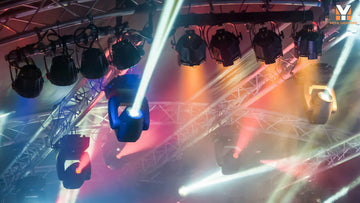All Articles
Demystifying Stage Lighting: A Comprehensive Exploration
by MIYA LASERS on Jan 16, 2024

Unveiling Conventional Stage Lights
In the world of stage lights, conventional stage lights have long been the epitome of traditional theater illumination. These light projector fixtures utilize analog quartz or tungsten halogen lamps, known for their affordability and suitability for quick stage setups with minimal initial investment.
To introduce color into the lighting scheme, conventional lights rely on the use of "gels," which are colored films positioned in front of the lights. The process of dimming and brightening conventional lights involves the modification of the electrical current supplied to them.

(A conventional ellipsoidal reflector light)
The LED Revolution: Transforming Stage Lighting
The advent of light-emitting diodes (LEDs) traces its origins back to the 1960s, but it wasn't until the post-2005 era that they truly revolutionized the events industry. Their popularity stems from several key factors, including their exceptional efficiency, extended lifespan, and, most importantly, their ability to produce vibrant and dynamic colors. As we delve deeper into this trend, it becomes evident that LED stage lightinghave outpaced their conventional counterparts.

LEDs far surpass conventional lights in terms of longevity, boasting an impressive lifespan of approximately 10,000 hours compared to the mere 2,000 hours of conventional lamps. While conventional bulbs are replaceable, the consistent maintenance required for their optimal performance can lead to substantial costs, making the relatively maintenance-free LED lamps a cost-effective choice.
What truly sets LED lighting apart is its remarkable capacity to generate any color instantaneously, a capability that conventional bulbs lacked in their early stages when limited to blending only red, green, and blue (RGB) colors.
The Dazzling World of Moving Lighting
Moving stage lighting, also known as moving-head lights, introduces a dynamic dimension to events that is truly captivating. These lights can be digitally redirected or repositioned during an event, either through pre-programmed sequences or real-time control by a skilled lighting engineer. It's worth noting that, due to their digital controllability, LED lights are more commonly used in moving-head fixtures compared to conventional lamps.

The "head" of these lights, housing the lamp, possesses the ability to pivot, rotate, or tilt to manipulate the direction of the light beam, while the base remains stationary, often secured to trusses or the stage floor. This flexibility empowers moving-head lights to create mesmerizing effects in various settings, including concerts, theaters, and corporate events.
Furthermore, the mobility of these lights contributes to a reduction in the overall number of fixtures required for an event. When combined with the color-changing capabilities of LEDs, this significantly decreases the demand for lighting compared to static conventional setups.

(A spotlight on two ballet dancers)
Balancing Costs: LED vs. Conventional
While the initial investment in LED lights may exceed that of conventional lighting, the long-term savings achieved through reduced maintenance and energy costs make LEDs a potentially economical choice for stage lighting.
This comprehensive guide is dedicated to shedding light on the distinctions among common stage lighting sources, offering insights into both conventional and LED lighting, and exploring the dynamic realm of moving-head lights. For more enlightening content from MIYA, make sure to subscribe to our newsletter!
